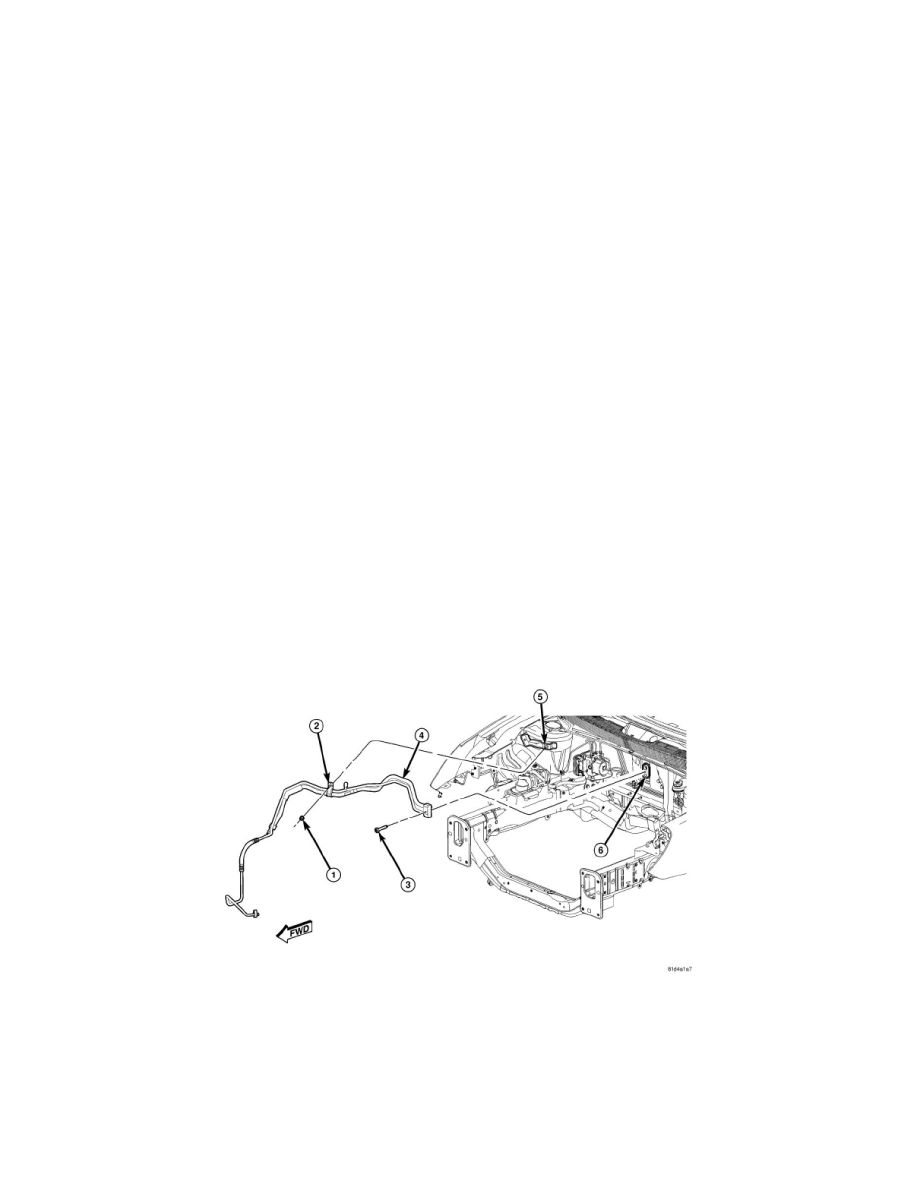Avenger V6-3.5L (2008)

8. Raise and support the vehicle.
9. Remove the tape or plugs from the discharge line fitting and the compressor port.
10. Lubricate a new rubber O-ring seal with clean refrigerant oil and install it and a new gasket onto the discharge line fitting. Use only the specified
O-ring as it is made of a special material for the R-134a system. Use only refrigerant oil of the type recommended for the A/C compressor in the
vehicle.
11. Connect the A/C discharge line (2) to the A/C compressor (3).
12. Install the nut (1) that secures the A/C discharge line to the A/C compressor. Tighten the nut to 20 Nm (15 ft. lbs.).
13. Install the splash shield onto the right side frame rail See: Body and Frame/Fender/Front Fender/Front Fender Liner/Service and Repair/Front
Wheelhouse Splash Shield - Installation.
14. Lower the vehicle.
15. Reconnect the negative battery cable.
CAUTION: Do NOT run the engine with a vacuum pump in operation or with a vacuum present within the A/C system. Failure to follow
this caution will result in serious A/C compressor damage.
16. Evacuate the refrigerant system See: Service and Repair/Procedures/Refrigerant System Evacuate.
17. Adjust the refrigerant oil level See: Service and Repair/Procedures/Refrigerant Oil Level.
18. Charge the refrigerant system See: Service and Repair/Procedures/Refrigerant System Charge.
Liquid Line
INSTALLATION
CAUTION: Be certain to adjust the refrigerant oil level when servicing the A/C refrigerant system See: Service and
Repair/Procedures/Refrigerant Oil Level. Failure to properly adjust the refrigerant oil level will prevent the A/C system from operating as
designed and can cause serious A/C compressor damage.
CAUTION: The A/C liquid line must be replaced if an internal failure of the A/C compressor has occurred. Failure to replace the A/C liquid
line can prevent the A/C system from operating as designed and can cause serious A/C compressor damage.
NOTE: When replacing multiple A/C system components, refer to the Refrigerant Oil Capacities chart to determine how much oil should be
added to the refrigerant systemSee: Service and Repair/Procedures/Refrigerant Oil Level.
NOTE: Replacement of the refrigerant line O-ring seals and gaskets is required anytime a refrigerant line is opened. Failure to replace the
rubber O-ring seals and metal gaskets could result in a refrigerant system leak.
NOTE: LHD model shown in illustrations. RHD model similar.
1. Position the A/C liquid and suction line assembly (4) into the engine compartment.
2. Remove the tape or plugs from the refrigerant line fittings and the evaporator ports.
3. Lubricate the rubber O-rings on new dual-plane seals with clean refrigerant oil and install the seals onto the liquid and suction line fittings. Use
only the specified seals as they are made of special materials compatible to the R-134a system. Use only refrigerant oil of the type recommended
for the A/C compressor in the vehicle.
4. Connect the A/C liquid and suction line assembly to the A/C evaporator (6).
5. Install the bolt (3) that secures the A/C liquid and suction line assembly to the A/C evaporator. Tighten the bolt to 25 Nm (18 ft. lbs.).
6. On RHD models, engage the retainers that secure the power brake booster vacuum supply hose to the dash panel.
7. Install the nut (1) that secures the refrigerant line bracket (2) to the right front strut tower (5). Tighten the nut to 20 Nm (15 ft. lbs.).
